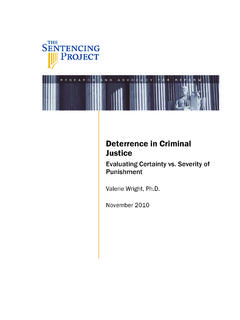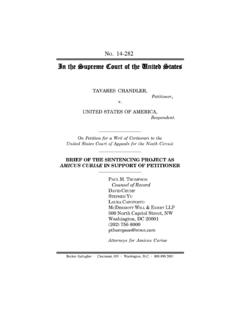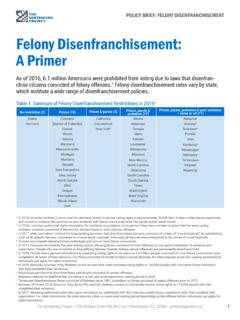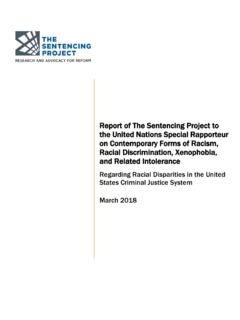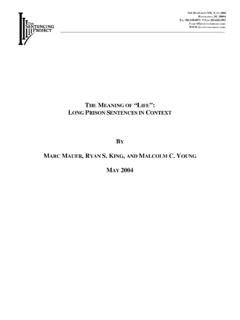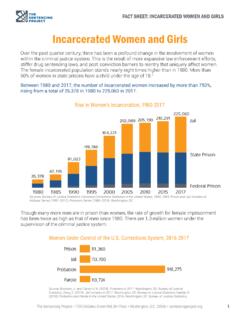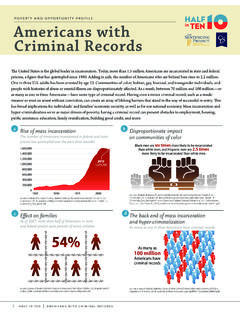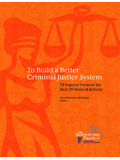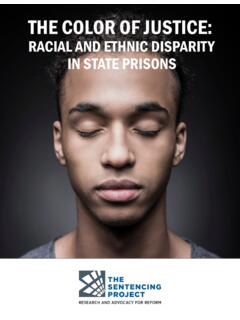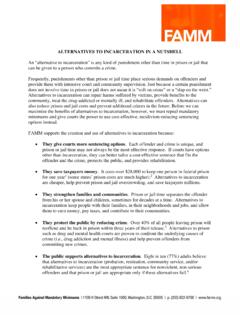Transcription of Incarceration and Crime: A Complex Relationship
1 Incarceration and Crime: A Complex RelationshipIncreasing Incarceration while ignoring more effective approaches will impose a heavy burden upon courts, corrections and communities, while providing a marginal impact on crime. This report was written by Ryan S. King (Research Associate), Marc Mauer (Executive Director) and Malcolm C. Young (Executive Director, 1986 2005) of The sentencing Project. Graphic Design by Michael T. sentencing Project is a national nonprofit organization that works for a fair and effective criminal justice system by promoting alternatives to Incarceration , reforms in sentencing law and practice, and better use of community-based services and institutions. To these ends, it seeks to recast the public debate on crime and punishment . Funding for this project was provided by the JEHT Foundation, the Open Society Institute and individual donors to The sentencing 2005 by The sentencing Project. Reproduction of this document in full or in part, in print or electronic format, only by permission of The sentencing Project.
2 For further information: The sentencing Project, 514 10th Street , Suite 1000, Washington. 20004. Telephone: : Over the past thirty years the United States has experienced an unprecedented rise in the use of Incarceration , with the number of people in prisons and jails increasing from 330,000 in 1972 to million today. This trend is in sharp contrast to that of the preceding fifty years, during which time there was a gradual increase in the use of Incarceration that was commensurate with growth in the general population. Between 1920 and 1970 the overall population nearly doubled, while the number of people in prison increased at just a slightly higher pace. However, between 1970 and 2000, while the general population rose by less than 40%, the number of people in prison and jail rose by more than 500%. Potential explanations for this dramatic change in policy have included changing crime rates, politics, demographics, and cultural The record decline in crime during the 1990s has added an additional element to the discussion.
3 Advocates of increased use of Incarceration have contended that the significant growth in Incarceration has been the primary factor responsible for this reduction. The two-pronged approach of tougher sentences and restrictive release patterns are the primary cause, proponents claim, of this sustained crime drop. Nowhere has the adoption of tougher sentencing rules and release policies been more evident than in the federal system, where mandatory minimums, sentencing guidelines, and the abolition of parole have combined to create an extremely punitive 1 For a discussion of the possible explanations for this shift in Incarceration policy, see Garland, D. (2001). The Culture of Control: Crime and Social Order in Contemporary Society. Chicago: University of Chicago The Department of Justice, in supporting this approach, has stated that tough sentencing means less crime, and that [t]he sentencing Guidelines have helped reduce crime by ensuring that criminal sentences take violent offenders off the streets, impose just punishment and deter others from committing crimes.
4 2 Despite these assertions by the Department of Justice, such a direct link is far from an accepted fact. As policymakers consider responses, including the adoption of a host of additional mandatory minimums, to the Supreme Court s 2005 remedial ruling making the federal guidelines advisory in v. Booker, it is important to assess what is actually known about the impact of imprisonment on crime Prepared Remarks of Assistant Attorney General Christo-pher A. Wray, Response to Booker/Fanfan, January 12, and Crime0300,000600,000900,0001,200,0001,50 0,0001,494,2161,331,2781,085,022739,9804 80,568315,97491,669 Figure incarcerated Persons in state and Federal Prisons, 925-2004166,123210,895 1925 1950 1965 1980 1985 1990 1995 2000 2004 Note: Figures do not include persons in local Crime2 Analyzing the Relationship Between Incarceration and CrimeThe Relationship between Incarceration and crime is Complex . Researchers have struggled to quantify accurately the degree to which crime reduction is attributable to imprisonment.
5 Among the many challenges associated with the issue are the following: distinguishing between state and national trends; differing measures of crime and victimization; and, assessing various time frames for analysis. In addition to Incarceration , studies have identified a range of factors which may affect crime, including general economic trends, employment rates, age, demographics, rates of drug abuse, and geographic variation. This briefing paper provides an aid to policymakers and the public by reviewing what is known about the effects of Incarceration on Methods of Measuring Crime Rates and VictimizationThere are two primary measures of crime used in the United States. The Uniform Crime Reports (UCR) produced annually by the FBI measure crimes reported to the police. The UCR Index Crime measure is a composite of eight serious violent and property offenses, and is commonly referred to as the crime rate in the media. Victimization studies conducted by the Department of Justice measure crime through surveys of households, asking occupants about crimes committed against them and whether or not they reported them to the police (less than half of all serious crimes are reported to the police).
6 Each means of measurement has its advantages. The victimization studies provide a broader view of total crime because they account for the many crimes not reported to the police, while the UCR provides a better sense of trends in the most serious crimes. Trends in the two measurements have been inconsistent in some time periods, but they match up about 60 to 75% of the time, depending on the type of crime However, most popular discussion of crime rates relies primarily on UCR data because of its focus on serious of these crime measures incorporate any assessment of drug offenses, since personal drug use or drug sales, apart from those resulting in arrests, are not reported to the police or as victimizations. The proportion of arrests, convictions, and persons incarcerated for drug offenses has increased dramatically in the past two Accordingly, this absence of data greatly obscures the overall number of people engaged in illegal activity and skews the national perception of actual trends in criminal Trends Depend Upon Time Frame ExaminedWhile there has been a great deal of discussion and speculation regarding the crime decline since the early 1990s, a focus on this period risks employing an overly narrow view of the Relationship between Incarceration and crime.
7 To be more completely analyzed, this Relationship should incorporate an assessment of the unprecedented increase in imprisonment since 1972. From a combined inmate 3 Rand, and Rennison, (2002). True Crime Stories? Accounting for Differences in our National Crime Indicators, Chance, Vol. 15 (1), p. Bureau of Justice Statistics, Drug & Crime Facts, < >. Accessed August 29, 2005. 1984 19911991 1998% Increase In rate ofIncarceratIon% Increase In crIme rate47%-22%% Increase In rate ofIncarceratIon% Decrease In crIme rate65%17%Figure 2divergent trends in Incarceration and crime rates2 Incarcerationand Crime population of about 330,000 in prison and jail in 1972, there has since been a five-fold increase to a total of million as of 2004. This escalating growth over a 30-year period has been accompanied by sharply divergent trends in crime rates. We can see this clearly in looking at the 14-year time frame of 1984-1998. During this period, Incarceration rates rose consistently, by 65% in the first seven-year period of 1984-91, and then by 47% from 1991-98.
8 Yet crime rates fluctuated in this period, first increasing by 17% from 1984-91, then declining by 22% from 1991-98. (See Fig. 2).There were also divergent trends in crime rates among the states during the crime decline period of 1991-1998. A number of states with large increases in Incarceration experienced smaller drops in crime than did states that increased their use of imprisonment at a lower rate. For example, Texas, with a 144% increase in Incarceration and California, with a 52% increase, experienced considerable declines in crime (35% and 36% respectively), but New York experienced a 43% decline in crime despite an increase in Incarceration of only 24%. An overview of changes in Incarceration and crime in all 50 states reveals no consistent Relationship between the rate at which Incarceration increased and the rate at which crime inconsistent trends over time and among the states do not necessarily suggest that Incarceration has no impact on crime, but they inform us that Incarceration does not always have a uniformly positive impact on reducing crime and that, therefore, other factors significantly affect crime the nation celebrates a reported crime rate that is near a 40-year low, it is instructive to note that despite the addition of more than one million persons to the prison population (excluding jail inmates), crime rates are only at the level at which they were at a time when the number of prisoners was just a fraction of the total Historical rates from Tonry, M.
9 (1995). Malign Neglect: Race, Crime, and punishment in America. New York: Ox-ford University Press. Pp. 22-23; current rates from Federal Bureau of Investigation. Crime in the United States, 2003. Washington, Crime Decline of the Past DecadeNationally, violent crime has declined by 33% and property crime has decreased 23% since 1994. During the same period Incarceration rates rose by 24%. Some commentators draw upon these two trends to support the conclusion that Incarceration works to reduce crime. The reality is far more to national data alone obscure the significance of the experience in the states as they utilize different strategies and achieve different results. A recent study that analyzed state prison and crime data revealed that there was no discernible pattern of states with higher rates of increase in Incarceration experiencing more significant declines in Between 1991 and 1998, those states that increased Incarceration at rates that were less than the national average experienced a larger decline in crime rates than those states that increased Incarceration at rates higher than the national average (See Fig.)
10 3). 6 Gainsborough, J. & Mauer, M. (2000). Diminishing Returns: Crime and Incarceration in the 1990s. Washington, DC: The sentencing Project. (p. 10).above averagebelow average% Increase In rate ofIncarceratIon% Decrease In crIme rate30%-17%% Increase In rate ofIncarceratIon% Decrease In crIme rate72%-13%Figure changes in Incarceration and crime rates For statesgrouped by above average and below average increases in Incarceration , 1991-1998 Incarcerationand Crime45 Trends between 1998 and 2003 at the state level continue to demonstrate no significant impact of increased Incarceration rates on reducing crime. Since 1998, 12 states experienced stable or declining Incarceration rates, yet the 12% average decrease in crime rates in these states was the same as in the 38 states in which rates of imprisonment increased. If Incarceration was having the impact on crime that proponents suggest, then those states with higher increases in Incarceration rates should have experienced more substantial declines in crime rates.
